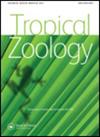Population biology of the freshwater prawn Macrobrachium brasiliense (Heller, 1862) in the Middle Amazon Region, Brazil
IF 0.4
4区 生物学
Q4 ZOOLOGY
引用次数: 7
Abstract
The population structure and reproduction of Macrobrachium brasiliense were studied with the aim of better understanding the ecology of this species in relation to the Amazonian flood-pulse regime. A total of 3,306 animals were caught monthly from August 2011 to July 2013 at the Carú River, Itacoatiara, Amazonas State (Brazil). The average carapace length of males (6.87 ± 3.45 mm) and females (6.88 ± 4.78 mm) did not differ significantly (U = 0.608; p= 0.5432) for the overall study period. The sex ratio was biased toward females (M:F = 1:1.61; χ2=83.855; p< 0.0001). The reproduction was continuous, and although juveniles were present throughout the study period, the recruitment occurred primarily during the ebb (August–September) and drought (October–December) periods. Macrobrachium brasiliense presents a low number of large eggs, and egg volume increased during embryogenesis, by 21.1% from Stage I to III. The population size-frequency distribution presented no correlation with the abiotic variables, but its reproductive period seems to be related to the Amazonian flood-pulse regime.巴西亚马逊河中部地区淡水对虾巴西沼虾(Heller, 1862)的种群生物学
研究了巴西沼虾的种群结构和繁殖,目的是更好地了解该物种与亚马逊洪水脉冲状态的生态关系。2011年8月至2013年7月,在亚马逊州(巴西)伊塔科蒂亚拉的Carú河每月共捕获3306只动物。雄性的平均甲壳长度(6.87 ± 3.45 mm)和雌性(6.88 ± 4.78 mm)没有显著差异(U = 0.608;p=0.5432)。性别比例偏向女性(M:F = 1:1.61;χ2=83.855;p<0.0001)。繁殖是连续的,尽管在整个研究期间都有幼崽,但繁殖主要发生在低潮期(8月至9月)和干旱期(10月至12月)。巴西沼虾(Macrobrachium brasiliense)的大卵数量较少,胚胎发生过程中卵体积增加,从第一阶段到第三阶段增加了21.1%。种群大小频率分布与非生物变量无关,但其繁殖期似乎与亚马逊洪水脉冲状态有关。
本文章由计算机程序翻译,如有差异,请以英文原文为准。
求助全文
约1分钟内获得全文
求助全文
来源期刊

Tropical Zoology
生物-动物学
CiteScore
2.50
自引率
0.00%
发文量
1
审稿时长
>12 weeks
期刊介绍:
Tropical Zoology is an international zoological journal publishing original papers in the field of systematics, biogeography, phylogeny, ecology and conservation of all terrestrial and aquatic animal Phyla from tropical and subtropical areas.
Only papers with new information, high quality and broad interest are considered. Single species description and checklists are not normally accepted. Review papers are welcome. The journal is owned by the Istituto di Ricerca sugli Ecosistemi Terrestri of the Consiglio Nazionale delle Ricerche, Florence, Italy (CNR-IRET) who performs research into the structure and functioning of aquatic and terrestrial ecosystems, focusing in particular on anthropogenic pressure and global change. The knowledge amassed forms the scientific basis for identifying the most appropriate protective and corrective interventions, and provides support for the bodies entrusted with formulating policies for environmental protection and recovery.
 求助内容:
求助内容: 应助结果提醒方式:
应助结果提醒方式:


